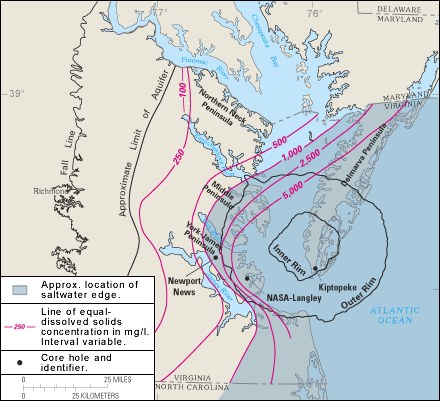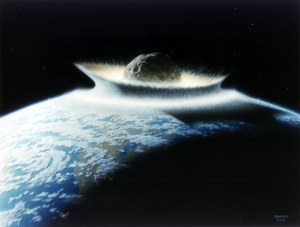The Chesapeake Bay impact crater in Virginia is the largest known crater in the United States. It was formed when a massive chunk of extraterrestrial rock hit the earth about 35.5 million years ago, during the late Eocene. This impact crated embedded and persevered in the sea floor is of particular geological interest because it was formed by impact with a wet target in what were shallow swampy waters during this epoch. Moreover, the Chesapeake Bay area of the United States’ eastern seaboard partly owes its distinctive geography to the presence of this impact crater.
Researchers have studied the hidden crater extensively using seismology, gravity surveying, and geological drill cores. However, scientists are still unclear as to the size of the asteroid or comet that created it and what effect the impact may have had on the environment.

Gareth Collins
Now, Gareth Collins at Imperial College London, working with Kai Wunnemann of the University of Arizona, in Tucson has used detailed computer simulations to recreate the impact event virtually with a view to calculating the size and shape of the asteroid. Collins and Wunnemann discovered that formation of the Chesapeake Bay crater was dramatically influenced by strength differences between the hard bedrock and the weak overlying sediments at the impact site.
Collins’ and Wunnemann’s modelling work suggests that craters formed in such wet targets are much shallower and broader than their counterparts formed in uniformly hard rock. They explain that had the impact occurred on dry land rather than off the coast, the final crater diameter would have been much smaller, just 40 km or so, rather than the observed 80-90 km of the Chesapeake crater.

Chesapeake Bay – Map from USGS
The model reproduces many of the structural features of the Chesapeake Bay crater seismic data. A deep basin is formed near the crater centre that contains inwardly collapsed sediments and is bounded by a ring of uplifted basement, explain the researchers. Outside of this, the model predicts a shallower outer basin where deformation is confined to the sedimentary layer. They also estimate the diameter of the transient crater to be 28 km, which is much smaller than previous estimates of 40 km or so. The researchers conclude that the Chesapeake Bay impact must have been a lot less energetic than scientists had previously assumed. This has important consequences for the impact of such an impact on the environment at the time and was probably far less catastrophic and extensive than imagined. Whether this finding will calm the nerves of those paranoid about future asteroids is a different matter.

Asteroid impact
Further reading
Geology, 2005, 33, 925-928
http://dx.doi.org/10.1130/G21854.1
Gareth Collins’ page
http://www3.imperial.ac.uk/people/g.collins
Lunar and Planetary Laboratory, University of Arizona
http://www.lpl.arizona.edu/
Suggested searches
asteroids
impact craters
seismic data